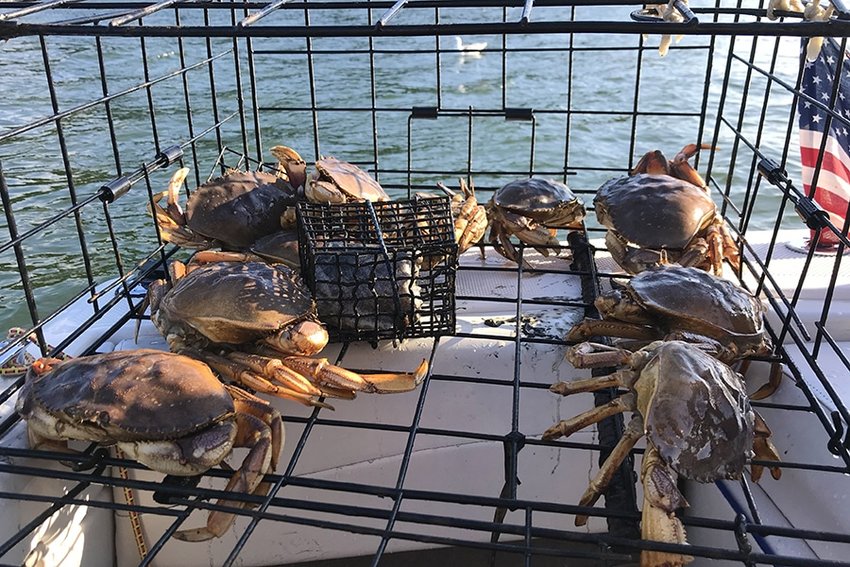 Photo: Caleb Galbreath, KP News
Photo: Caleb Galbreath, KP News
Although Gov. Jay Inslee has lifted fishing restrictions in the state due to COVID-19 concerns, crabbing in South Puget Sound will likely remain closed to all crab harvesting for the third year in a row.
The Dungeness crab population, which is monitored by the Washington Department of Fish and Wildlife and the tribes through test fisheries, continues to be dangerously low in Marine Area 13, the part of Puget Sound south of the Narrows Bridge. Marine Area 11, just to the north of the bridge, has shown some improvement and will be open for crabbing this year. The other marine areas in Washington, with the exception of south Hood Canal, have historically had higher numbers as a baseline and continue to have stable crab populations.
According to data from the WDFW, the crab harvest in Marine Area 13 fell from a peak of 285,505 pounds in 2012 to 9,457 pounds in 2017, a decline of 96.7 percent.
The number of legal-sized male Dungeness crab remains low. In 2020 the test traps had an average of 0.6 legal-sized male per trap, an improvement from 2018, but still just half the number seen in 2014. This contrasted to an average of 17 to 34 per trap in the Whidbey Island area. In addition, there was only one crab in the size range of 3.5 to 5.7 inches — there were none in 2017 – an indication that several year classes of Dungeness crab are still missing.
According to WDFW, overharvesting is unlikely to be the cause of falling numbers because of the reproductive characteristics of the crustacean. Female Dungeness crab are able to store sperm from mating for up to two-and-a-half years, and male crabs can mate at least once before they reach legal harvesting size. Once fertilized eggs are released, the larvae remain suspended in water for about four months before settling to the bottom. Where the larvae settle depends on tides and currents. It takes about five years for crabs to reach the legal harvesting size of 6.25 inches.
If overharvesting were the problem, recovery would be seen within a few years, and that has not been the case. The failure of the crab population to recover, even in the absence of harvest pressure, may indicate that larval crab are not surviving into adulthood. Factors that could contribute to this include changes in physical oceanography limiting the movement of larva from one region of Puget Sound to another, as well as chronic effects of changing ocean conditions such as warming surface waters, ocean acidification, pollutant levels and lower oxygen levels.
Until recently there was little indication that Dungeness crab were vulnerable to current levels of ocean acidification observed along the West Coast. But a study published in the May 10 issue of Science of the Total Environment, an international peer-reviewed journal covering environmental science, suggested that acidification already had an effect on larvae. The study, funded by the National Oceanic and Atmospheric Administration, demonstrated that acidification in some coastal waters was associated with adverse effects on the shell that could cause developmental delays, which could increase energy demands, interfere with maturation and cause problems with sensory organs.
Daniel Sund, a crustacean biologist with WDFW, said, “We are a ways away from being able to quantitatively account for the impacts of ocean acidification and hypoxia, or integrate these factors into how we manage crustacean fisheries along the West Coast or in Puget Sound. Studies like those recently published lay the groundwork for being able to understand how crustacean resources will respond to rapidly changing and highly variable ocean conditions.”
Although the South Sound red rock crab population appears to be intact, crabbing for all species may be prohibited pending a final review. Dungeness crab, even if released from traps, would be injured if a red rock-only fishery was implemented and any additional stress and mortality must be avoided to allow the resource the best chance possible to recover. In addition, it is difficult to enforce a closure for just one species when the same equipment is used to harvest both, according to WDFW.
UNDERWRITTEN BY THE FUND FOR NONPROFIT NEWS (NEWSMATCH) AT THE MIAMI FOUNDATION, THE ANGEL GUILD, ADVERTISERS, DONORS AND PEOPLE WHO SUPPORT INDEPENDENT, NONPROFIT LOCAL NEWS